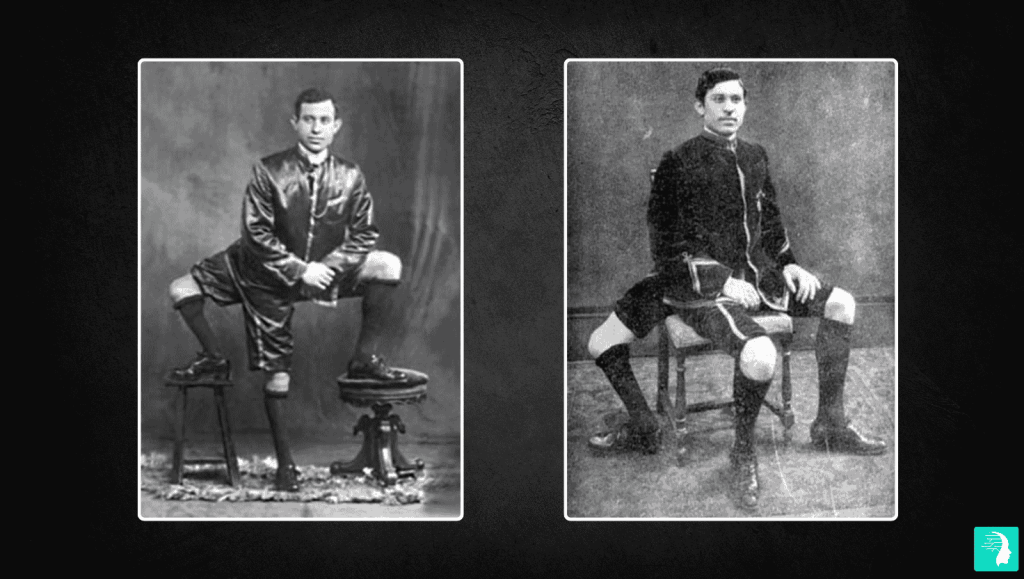Have you ever wondered about the extraordinary individuals who shaped our understanding of human anatomy? Let me introduce you to Juan Baptista dos Santos, a fascinating figure from the 19th century whose unique physical characteristics revolutionized medical science and challenged societal norms.

The Early Life of Juan Baptista dos Santos
Born in 1843 in Portugal, Juan Baptista dos Santos wasn’t just another face in the crowd. Nature had blessed him with something extraordinary – a condition that would later captivate both medical professionals and the public alike. Imagine being born with three legs and duplicate reproductive organs! It sounds like something from a fiction novel, but this was dos Santos’s reality.
What made his case particularly intriguing was that he came from an otherwise ordinary family background. Unlike many with congenital conditions, dos Santos didn’t let his unique anatomy hold him back. In fact, he embraced it with remarkable grace and adaptability.
A Medical Marvel: Understanding dos Santos’s Unique Anatomy
Let’s dive into what made dos Santos truly unique:
- He was born with tripedalism (three legs)
- His condition included diphallia (two fully functioning reproductive organs)
- Some medical reports suggested the presence of three or four testicles
- His third leg, actually two fused limbs, had a functioning joint
Here’s the fascinating part – he didn’t just cope with these differences; he thrived! Picture this: a man with three legs, confidently riding horses and living life to the fullest. It’s no wonder he caught the attention of medical professionals across Europe.
From Medical Curiosity to Sideshow Star
The 19th century was a time of great scientific curiosity, but it was also an era of public spectacles. Dos Santos found himself at the intersection of both worlds. Handsome and charismatic, he became a sensation in European medical circuses and exhibitions. But he wasn’t just a passive subject – he took control of his narrative and turned his unique condition into an opportunity.
Love in the Most Unexpected Places
Now, here’s where the story takes an interesting turn. Remember Blanche Dumas? She was another remarkable individual with similar anatomical uniqueness – three legs and duplicate reproductive organs. Their paths crossed in the most unexpected way, leading to what contemporary accounts describe as a passionate affair. It’s a testament to how love finds its way, regardless of physical differences.
Legacy and Modern Relevance
Think about it – in today’s world of body positivity and acceptance, dos Santos’s story feels surprisingly modern. He challenged 19th-century notions of normalcy and helped pave the way for broader discussions about human diversity. His life raises important questions about how we view and treat those who are different.
What Can We Learn from Juan Baptista dos Santos?
His story teaches us valuable lessons about:
- The incredible adaptability of the human body
- The importance of embracing our uniqueness
- How medical understanding can be advanced through studying unusual cases
- The evolution of society’s attitude toward physical differences
The Impact on Medical Science
Dos Santos’s case contributed significantly to our understanding of congenital conditions. Medical professionals of his time documented his condition extensively, providing valuable insights that still inform modern medicine. It’s remarkable how one individual’s unique anatomy could advance medical knowledge so significantly.
Conclusion: More Than Just a Medical Marvel
Juan Baptista dos Santos was more than just a medical curiosity – he was a pioneer who challenged societal norms and helped reshape our understanding of human anatomy. His legacy lives on, not just in medical textbooks, but as a powerful reminder that what makes us different can also make us extraordinary.
In a world that often struggles with accepting differences, the story of Juan Baptista dos Santos remains remarkably relevant. He showed us that being different isn’t a limitation – it’s what makes each of us uniquely human.
This article provides a glimpse into the extraordinary life of Juan Baptista dos Santos, a 19th-century figure whose unique anatomy and remarkable spirit continue to inspire discussions about human diversity and medical advancement.
Related Medical Oddities
7 Historical Medical Cases That Stunned Victorian Doctors
Discover bizarre 19th-century medical cases, including conjoined twins, mysterious conditions, and shocking discoveries.
Grace McDaniels: The Mule-Faced Woman
The inspiring story of Grace McDaniels, a woman born with a rare facial condition who built a successful career in sideshows.
Pip and Flip: The Snow Sisters’ Sideshow Legacy
Meet Pip and Flip, conjoined twins with microcephaly who captivated audiences and left a lasting impact on sideshow history.
The Real Pepper from American Horror Story
Uncover the true story of Schlitzie, the real-life inspiration behind the iconic Pepper character from AHS.
Blanche Dumas: A 19th Century Medical Marvel
Blanche Dumas defied medical expectations with her extraordinary anatomy, leading a fascinating and unconventional life.
Betty Lou Williams: The Four-Legged Marvel
Discover the extraordinary story of Betty Lou Williams, a woman born with four legs, and how she amazed the medical world.

2 thoughts on “Juan Baptista dos Santos: The Remarkable Story of a 19th Century Medical Marvel”
Pingback: The Real Pepper: From American Horror Story
Pingback: Pip and Flip: The Snow Sisters' Remarkable Sideshow Legacy